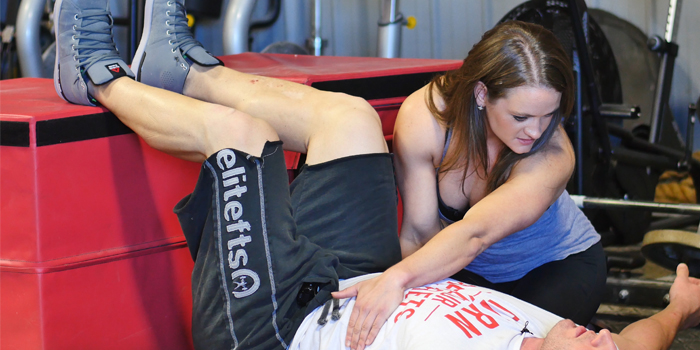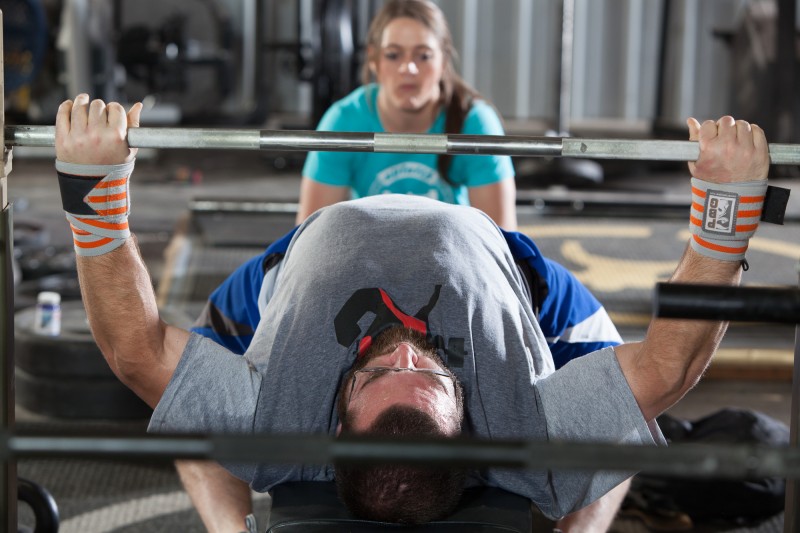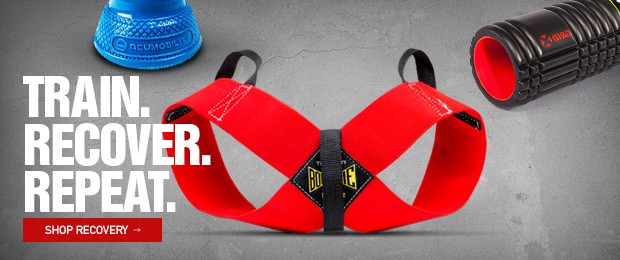
David LaMartina will deadlift and squat under almost any circumstance — unless he’s concerned that it puts his long-term ability to train in question. This is the second article detailing exactly what David did and what it takes to get back to the platform and compete after a pile of injuries and pulling out of multiple meets, including Boss of Bosses 3.
Obviously, I’m biased and got a closer look as he’s my husband, but as a physical therapist and competitive lifter, I can’t overstate the importance of all the things he’s learned (and I’ve learned with him) throughout this process. Coming back after one tweak or tear—or maybe even two—is one thing, but having to pull out of multiple meets and having to question everything waist-down is a different story. If you’ve been in this sport longer than a few years, you know how easy it is to fall into this bucket of mud without even realizing you’d dipped your toe in it.
I mentioned the “long-term ability to train” in the first paragraph because that is what this is all about. At some point in this sport, you’re going to hit a point where you either stop making quick progress and have to be a lot smarter, or you accumulate injury to the point where you’re likely training around one or two at a time and just trying to make it to the next meet. Usually, at this point, people lose their “passion.” They quit and send their time elsewhere because it got hard. No shame in that, but if you do truly love this sport, you’ll realize that at some point, there’s an exchange that happens. You’ve made a choice to make training a priority, but it’s under threat at least a few times a year. You sacrifice your time, finances, and physical body to do what you love. The psychology of the uneven exchange, I think, is what can make this scary. You give a lot to something that at any point if things go wrong, you may no longer be able to do. The security of the long-term investment isn’t there.
RECENT: Back to the Platform After Injury: The First Steps
The shift that I see in every strength athlete I work with that gets better is that they shift their mindset from the short-term investment to the long-term. The whole first article in this series is about just that, and what Dave had to learn in that process. When he let go of the short-term threat to see the long-term forest through the trees, his rehab process felt like an entirely different one. The pressure is off, and the only focus is moving better and permitting healing without an unrealistic timeline. Until you can adopt the long-term mindset, “how” you go about actually getting better is going to feel like it constantly falls short. Once you’ve overcome that hurdle, you can start to move forward; what’s the reason more than one part of your body is taking so much stress to begin with?
Dave’s injuries started with what he believed was quad tendonitis, followed by a TFL tear, a subsequent SI issue, and finally a hamstring tear. He took his rehab “sort of" seriously up until the hamstring tear when he finally realized that if he didn’t change something, feeling heavy weight on his back or in his hands was probably not going to happen again. In order to get to the point of actually getting better and taking rehab seriously, a lifter must be willing to shift the paradigm from the short term to the long term. 12 weeks is a blink of an eye in what will accumulate as your training history.
Here’s a brief outline of what we did, and how I think most rehab for strength athletes should be structured.
Component 1: Addressing the Why
I preach on this in almost every article and will not stop. Generally, excessive stress beyond a tissue's capability equals injury. Simple. You can treat your quad tendinopathy, but until you figure out why it’s happening, you’ll probably be like Dave and have pain that moves wherever your body is offloading to. Don’t be like Dave (was).
For him, we got a little detailed knowing that his squat was his initial irritating factor but ultimately deadlifts caused his hamstring tear, and he noted some significant differences in elbow and wrist position on his bench as well. So really, something was up with his whole body in every lift. Through video and in-person sessions, it was pretty easy to see that his painful issues came down to poor position under the bar beyond just front/back and left/right. We had to look three-dimensionally at what was happening.
A few key indicators brought me here. Hamstring issues, especially in a closed chain exercise like squat or deadlift, are so rarely just sagittal plane, yet we think about them primarily as a knee flexor and secondary hip extensor, failing to appreciate the rotational component they can have, as well as what kind of rotation may be happening on the surface its anchored to (namely the pelvis).
After some tests, as well as some video, I realized that Dave really couldn’t rotate anywhere. I know, surprising — a powerlifter that doesn’t rotate well. That probably describes many of the dudes reading this article. Generally, he couldn’t rotate anywhere, and where you don’t have even small degrees of mobility, you're likely going to lack stabilization required for even small degrees of rotation. As long as he was locked in under the bar, he was strong and good to go, but at some point, his ability to maintain position proximally (think hips, core, upper back) decreased. And when you leak energy, you need to recover, increasing the demand for other joints, soft tissue structures, or muscles. My personal two cents is that some of his notorious high RPE, high rep sets got him through the set, but each repetition “taught” poor position over time — reason number 605 to be mindful of how you train.
Step one, then, became getting him more stable at his core, not by doing dead bugs or any traditional “stabilization” program. I really don’t think his core was weak so much as just in poor position from the moment he unracked the bar. Yes, he did some traditional core work (hello, Palloff pressing), but when muscles’ ability to stabilize largely depends on mechanical advantage, poor positioning may not even permit the body to stabilize with the strength it’s capable of. We focused largely on his ribcage (correctives went rib internal rotation with serratus facilitation, to assist in promoting neutral under load and to improve shoulder mechanics in his bench) and pelvis, knowing that if that base was set, we could always move distally as required (which we did end up doing by incorporating some ankle mobility with an emphasis on desired ankle to tibial position). Again, for him (and many of you), position is everything. If you’re feeling “off” in a lift, or injured, looking for changes in position is probably a good place to start.
MORE: Common Behaviors of Lifters Who Know How to Improve
It is important to note that we did change him from alternating grip to hook grip on his deadlift, and narrowed his stance to improve overall position based on his build and body type. For those of you willing to nerd out a bit, appreciate that by sheer virtue of the fact that he is in closed chain, and his pelvis is moving on his femur as he descends in a squat, there is a rotational demand on his hip (and entire pelvis, really) regardless of whether it “looks like” it is rotating. Hip socket (acetabulum) moving on ball (femur) needs more attention, rather than always thinking femur on acetabulum. That isn’t where we live as iron sport athletes. Once you’ve regained mobility, it needs to be trained for stability in closed chain. Keep reading and I’ll roughly outline what we did. If you have detailed questions about how we did this, for sake of article length, you can email me at danicashdpt@gmail.com. We did work with tempo, bracing, soft tissue, and compound movements with some isolation.
Component 2: Soft Tissue
I’m fairly small and Dave’s a big dude. I will always get an athlete what they need, whether it comes from me or someone else. I’m lucky enough to work in a clinical environment and with a team that really is top notch and will never say, “Just stop deadlifting and squatting.” I knew we needed to get his body some sort of stimulus to “let go” and get some additional blood flow to where his hamstring tear was, so I handed Dave to one of my mentors for dry needling, with the caveat that he must follow his sessions with good, non-painful movement for retraining.
There is a time and a place for soft tissue work. When it becomes something an athlete does just to feel good, it doesn't lose its therapeutic value but it does become something that you're not necessarily going to quit needing. I don’t know about you, but my wallet, high cost of living in Fort Collins, and student loan debt really hates that expense. What I appreciated about my mentor Jon working with David is that he emphasized movement following therapy (as most “evidence” is saying) and put a timeline, as well as temporary session “limit” to be used sparingly on the situation to assess its effectiveness. This was not a “come in and I'll just make you feel better until your next session, and I want to see you twice a week while you’re in meet prep” Band-Aid so much as it was an encouragement to get his nervous system to chill out and provide it an opportunity to relearn how to move properly. Dave had a total of three needling sessions over the course of a month.
If a clinician needs to see you routinely, all the time, you should know why.
Component 3: Training
This is the actual training component. Let the athlete still be an athlete. Change the line of thinking from focused on what he can’t do to focused on finding ways to still train hard that will benefit him. This isn’t beating your head into the wall for the sake of training; this needs to be targeted. This, honestly, is where the money is with really getting back. He’s training for stimulus, work capacity, and to provide frequent sessions without neurogenic or psychological anticipation of pain, but he’s getting his ass kicked by working on the things that actually led to his injury. We got picky with where his stability was coming from with unilateral work, we gave the affected tissue blood flow, and when he was ready for bipedal movements, we were able to keep training difficulty high. I don’t know about you, but the more “normal” I can feel about training, the more mentally sane I stay.
Key movements included tempo squats, pause squats, more variations of single-leg lunging and hinging patterns than he knew existed (with good hinging mechanics and a neutral spine), and trap bar deadlifts with multiple variations. We progressed load and RPE weekly based on overall feel. Every single movement was performed with one key component: good ribcage to pelvis relationship.
He pulled sumo for the first time in months (405 for three reps) tentatively at the beginning of August and was back at 725 for easy reps September 19. He pulled 835 on October 30. His last pull before his first meet back was a solid 855 with zero hesitation, shown below.
The combination of addressing why, soft tissue work, and plenty of opportunity to stop the snowball of “painful” training sessions and rebuild positive momentum let him come back healthier to a point where he couldn’t stop saying how much he’d forgotten how fun training is when you don’t hurt.
The major takeaway is that strength developed from years of training does not disappear in a matter of months. Part of why this was so smooth for Dave was because his body was previously accommodated to it. He didn’t get that much “stronger” so much as his body quit perceiving every training session as a threat. If you’re looking to come back after long-term injuries, you need to shift your perspective and have a game plan that encompasses not only the tissue itself but also why it’s taking stress. You also must allow your body to have sessions where training is a positive stimulus, both neurologically and psychologically. Stop doing the things that hurt hoping today will magically be the day they don't hurt. Your body and brain remember that. There are so many other ways you can improve that won’t continue to train your nervous system to remember a movement or pattern as painful. Break the cycle and move on.











